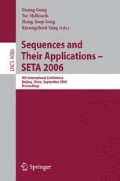Abstract
Interleave structure is a well-known period extending method, by which we can extend the period of an original ZCZ sequence family to generate a long period ZCZ sequence family. In this paper, we first present two basic period extending methods: 1. when period extends, the sequence number keeps unchangeable, while the zero correlation zone length extends; 2. when period extends, the zero correlation zone length keeps unchangeable or slightly decreased, while the sequence number extends. Then we propose the concept of D-matrix, by which to determine the shift sequence in the interleaved structure and to calculate the zero correlation zone length of interleaved ZCZ sequence families. In Section 3 and Section 4, two generating algorithms of interleaved ZCZ sequence families and the corresponding optimal D-matrix are proposed.
This work was supported by the National Natural Science Foundation of China (Grant 60373092).
Access this chapter
Tax calculation will be finalised at checkout
Purchases are for personal use only
Preview
Unable to display preview. Download preview PDF.
References
Fan, P.Z., Damell, M.: Sequences Design for Communications Applications. Research Studies Press, London (1996)
Fan, P.Z., Suehiro, N., Kuroyanagi, N., Deng, X.M.: Class of Binary Sequences with Zero Correlation Zone. IEE Electron. Lett. 35, 777–779 (1999)
Deng, X.M., Fan, P.Z.: Spreading Sequence Sets with Zero Correlation Zone. IEE Electron. Lett. 36, 982–983 (2000)
Suehiro, N.: Approximately Synchronized CDMA System without Cochannel Using Pseudo-periodic Sequences. In: Proc. Int. Symp. Personal communication 1993, Nanjing, China, pp. 179–184 (1994)
Tang, X.H., Fan, P.Z., Matsufuji, S.: Lower bounds on correlation of spreading sequence set with low or zero correlation zone. Electron. Lett. 36, 551–552 (2000)
Hayashi, T.: Binary sequences with orthogonal subsequences and zero correlation zone. IEICE Trans. Fundamentals E85 A, 1420–1425 (2002)
Hayashi, T.: A generalization of binary zero correlation zone sequence sets constructed from Hadamard matrices. IEICE Trans. Fundamentals E87-A, 286–291 (2004)
Matsufuji, S., Takatsukasa, K.: Ternary ZCZ sequence sets for efficient frequency usage. In: Proceedings of SCI 2000, pp. 119–123 (2000)
Torii, H., Nakamura, M., Suehiro, N.: A new class of zero correlation zone sequences. IEEE Trans. Inform. Theory 50, 559–565 (2004)
Gong, G.: Theory and applications of q-ary interleaved sequences. IEEE Trans. Inform. Theory 41, 400–411 (1995)
Gong, G.: New designs for signal sets with low cross correlation, balance property, and large linear span: GF(p) case. IEEE Trans. Inform. Theory 48, 2847–2867 (2002)
Author information
Authors and Affiliations
Editor information
Editors and Affiliations
Rights and permissions
Copyright information
© 2006 Springer-Verlag Berlin Heidelberg
About this paper
Cite this paper
Wang, JS., Qi, WF. (2006). Analysis of Designing Interleaved ZCZ Sequence Families. In: Gong, G., Helleseth, T., Song, HY., Yang, K. (eds) Sequences and Their Applications – SETA 2006. SETA 2006. Lecture Notes in Computer Science, vol 4086. Springer, Berlin, Heidelberg. https://doi.org/10.1007/11863854_11
Download citation
DOI: https://doi.org/10.1007/11863854_11
Publisher Name: Springer, Berlin, Heidelberg
Print ISBN: 978-3-540-44523-4
Online ISBN: 978-3-540-44524-1
eBook Packages: Computer ScienceComputer Science (R0)

